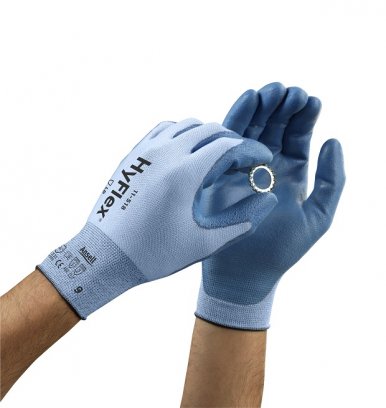
Groz-Beckert Webinar: Ultra-fine knitted fabrics
To protect employees from workplace cut hazards, Stihl, a German producer of heavy duty power chain saws, has chosen safety gloves that would not only meet the requirements of EN 388 cut level 3 in 18 gauge thinness, but also provide high comfort and maximum dexterity.

16th June 2014
Knitting Industry
|
The Netherlands
Stihl, a German manufacturer of chainsaws and other handheld power equipment, has selected safety gloves from Ansell composed of innovative high performance fibre that meet the requirements of EN 388 cut level 3 in 18 gauge thinness that to protect its employees from workplace cut hazards.
The new advanced fibre technology is said to deliver the highest ever cut-resistance for industrial safety gloves combined with high comfort and maximum dexterity.
During a recent review of safety gloves for employees at the company’s manufacturing plant in Wil, Switzerland, it was determined gloves meeting EN 388 cut level 3 offered required protection.
After extensive testing of a total of 13 different gloves, Stihl selected the HyFlex 11-518, highly cut-resistant safety glove, as by far the thinnest, lightest, most dexterous and most comfortable solution available in this protection class.
The HyFlex 11-518 glove meets the requirements of cut level 3 according to EN 388 and yet it is relatively thin for maximum dexterity, the company reports. The glove is breathable, abrasion resistant, and has a thin polyurethane coating on the palm side for optimum tactility.
The HyFlex 11-518 is made by Ansell, a leading manufacturer of safety protection solutions for manufacturing, medical and various other industries. HyFlex is believed to be made on an 18 gauge Shima Seiki NewSFG seamless glove knitting machine.
The new glove was developed in close collaboration with the fibre specialists at DSM Dyneema and is based on advanced Dyneema Diamond Technology.
This technology delivers a yarn with about half the weight and thickness of those used in traditional HMPE gloves. This makes it possible to create a finer knitting structure, resulting in higher flexibility and improved grip, without any compromises in cut, tear and abrasion resistance.
A cut resistant glove made with Dyneema Diamond Technology has a lower carbon footprint thanks to the need to use less material and its re-usability, making it overall a more sustainable solution, the manufacturer reports.
Gloves based on this technology can be washed and reused multiple times, depending on their use and wear, without losing their superior cut protection properties.
Roland Zürcher, safety expert at Stihl Kettenwerk explained: “We sought a safety glove that would significantly improve the cut protection for our employees as well as their willingness to wear them. The gloves we used previously were either too thick and heavy or didn’t offer enough protection.”
The new HyFlex safety gloves have been successfully in use for 12 months. According to the company, the new gloves have been met with a high level of acceptance among Stihl’s employees and there have been fewer hand injuries coupled with a positive effect on the costs of occupational safety insurance.
“We see a growing demand for thin yet extremely cut-resistant safety gloves in various markets,” commented Werner Schwarzberger, Senior Regional Sales Manager Industrial & Specialty Markets at Ansell.
“The Dyneema Diamond Technology used in the HyFlex 11-518 results in a glove that meets cut level 3 while at the same time providing the fingertip sensitivity of bare hands. DSM’s Dyneema Diamond Technology enables breakthrough achievement, as it allows us to reduce the required yarn diameter for this protection level by up to 50 percent versus conventional HMPE yarns.”

Business intelligence for the fibre, textiles and apparel industries: technologies, innovations, markets, investments, trade policy, sourcing, strategy...
Find out more